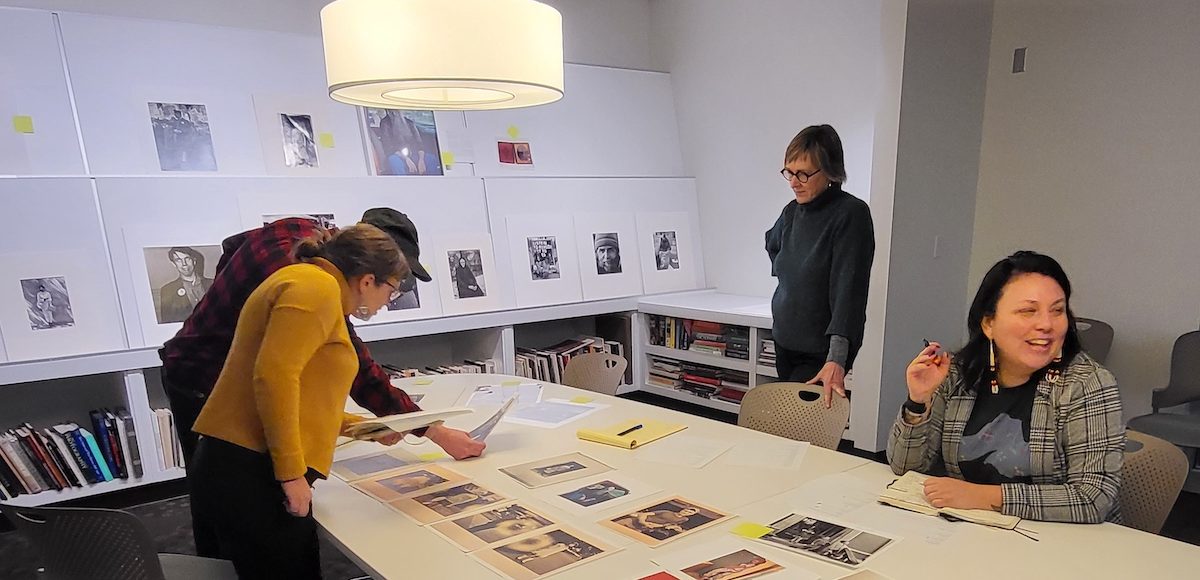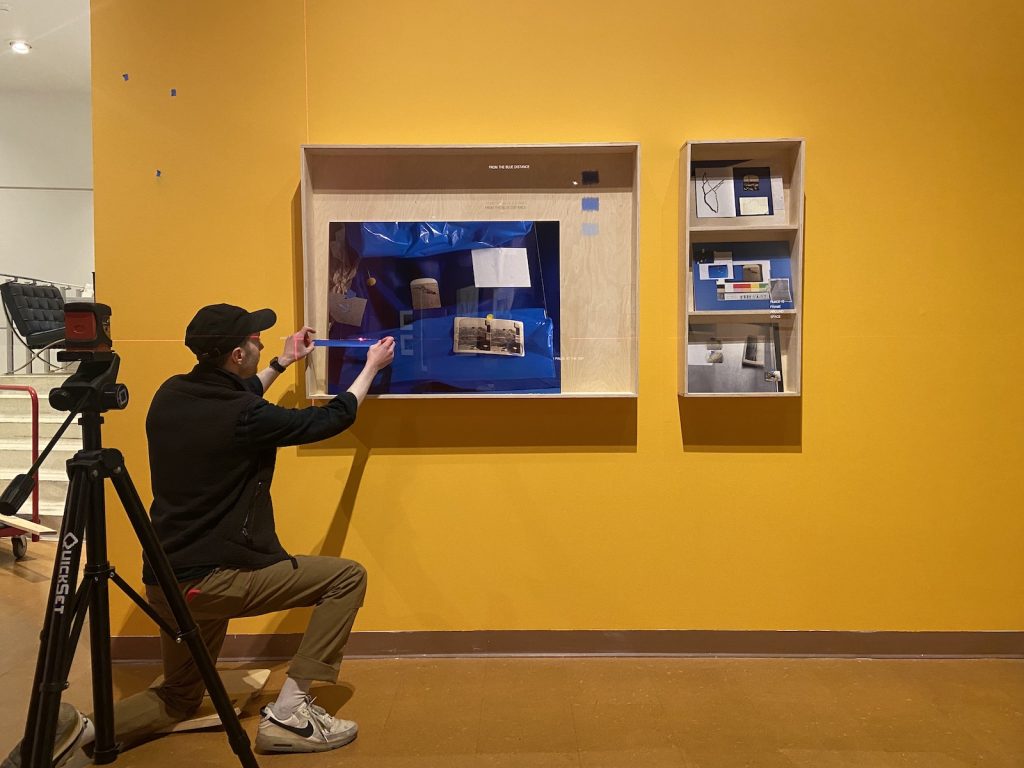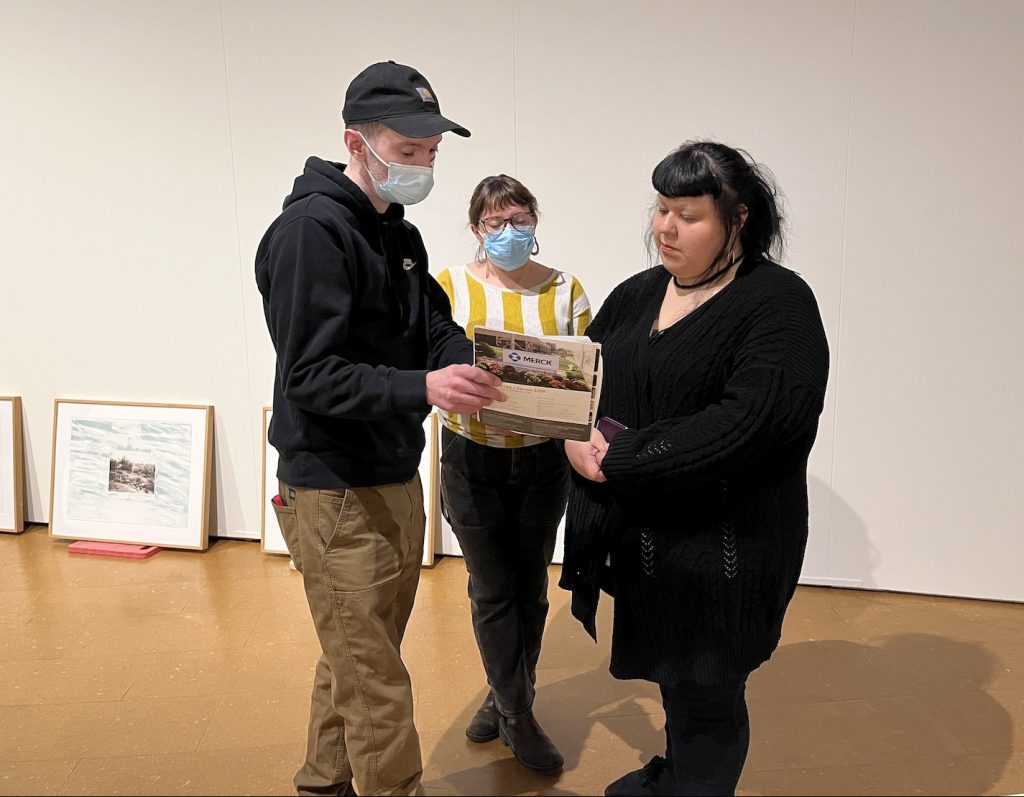Q&A with Marcella Ernest of Collective Constructs

Marcella Ernest engages in collaborative work both intellectually and as practice. She is Gunflint Lake Ojibwe and an enrolled member of the Bad River Band of Lake Superior and has heritage that includes Eastern European ancestry. Her interdisciplinary practice includes creative responses to the archive, research, writing, lecture + performance, sound, and video art. She explores oral histories and family photos as sites of memory and open-ended reflections on politics of place, and the varying relationships between social art history, gender, and Indigenous land justice. Marcella holds a PhD in American Studies and is currently an Assistant Professor of Native American Art History with the Department of Art Studio, History and Education at the University of New Mexico.
Marcella is working collaboratively with Collective Constructs to engage with UNMAM’s current exhibition, Hindsight Insight 2.0: Portraits, Landscapes and Abstraction from the UNM Art Museum. Other members include Marina Perez, UNM Ph.D. student in Art History, and Francis Reynolds and Anna Rotty, UNM MFA candidates in Studio Art. You can learn more about the background and work of Perez, Reynolds, and Rotty here.
To learn more about Collective Constructs, we asked Marcella a few questions about the group and their process:
What is Collective Constructs? How was the group formed?
Collective Constructs is a group of visual scholars working to facilitate original research, critical thinking, and collaborative learning. Formed on Tiwa land at the University of New Mexico, Collective Constructs centers visual sovereignty and remix strategies as tools of both analysis and creative liberatory practice. In our engagement with the UNM Art Museum, we center our understanding of American Indian Curatorial Practice as work that is long-term, mutually meaningful, reciprocal, and with mentorship. This is what Apache scholar and art curator Nancy Marie Mithlo calls “collective constructs.”1
In the fall 2022, I met with Mary Statzer, UNMAM Curator of Prints & Photographs. She asked me if I would be interested in contributing to a collection show at the UNM Art Museum. We discussed at length over the course of a few weeks what my contribution might look like. For example, Mary invited me to include my own art and/ or to curate a section of works from the collection. In the end, I wanted to use the opportunity and the space to elevate students and their work.
Beyond mentorship, I am always thinking about how to extend classroom discussions towards public scholarship and community engagement. So much of what I do and how I teach is about the process, over the product itself. Learning by doing. Making and building relationships. This is all very important to me. The invitation to contribute to a collection show, which is Hindsight Insight 2.0, is a great opportunity and a collaboration with students makes sense for me.
Another layer to answer the question of how Collective Constructs was formed, is from a graduate seminar. In the fall, I was teaching a class called “Visual Sovereignty and the Archive.” My concept of inviting three graduate students to collaborate with me is an extension of that class.
To return briefly to my proposal to the museum. As I said, I was invited to contribute. I accepted, with gratitude, but with a proposal. The proposal was that instead of my work and my voice alone, the gallery, and the collection, as archive, be open to students works and their voices, in conversations with me and the UNM Art Museum. Again, I want opportunities that offer students experiential learning through process. I want to recognize their thinking and to honor their academic excellence. That is what I am here for. I also want them to build relationships, (elevate that CV) and have fun. The museum said yes to these ideas. Then, I was able to ask three graduate students in the College of Fine Arts to be public scholars with me. I had existing relationships with each of them through studio visits, committee work and previous classes. They were all in the “Visual Sovereignty and the Archive” seminar and represent both Studio Art and Art History. In that way, the research was done. We had the foundation. We will continue to build upon that construct, collectively.

How is the group contributing to Hindsight Insight 2.0?
While we are not the curators of Hindsight Insight 2.0, we have contributed to its development in collaboration with the UNM Art Museum. In doing so, we have articulated a transdisciplinary response by centering art historical analysis with visual sovereignty and remix strategies that facilitate original research, critical thinking, and collaborative learning.
The “deliverables” includes a series of podcast style conversations that will be hosted online (;) two public lectures that are creative in form and presentation. These are an extension from a final class project from “Visual Sovereignty and the Archive” (;) two original art pieces by the students that will be included within the show itself. Importantly, they are not identified as “student work” but as artists, alongside other artists that have inspired us (;) one of them has included a family archival photograph that is incased behind glass and exhibited (;) there will be a zine stye publication (;) and questions that will be presented throughout our two spaces. Instead of making statements, we are asking questions. The questions are formulated towards other students. Activating the gallery as an educational space. For example, if we bring our students here, what types of things do we want them to consider? What vocabulary do we want them to engage? How can we utilize this museum space to build upon our curriculum in Art and Art History? Lastly, and most importantly, is the experience and the process itself: Art History and Art grads working collaboratively, having conversations, making relationships with museum staff, etc. All of this is an extension of our “Visual Sovereignty and Archives” class — elevating the family photo, the art making, developing questions, the thinking . . .



What are the benefits and challenges of working as a collective?
I have to say, first, Collective Constructs became identified as a collective because it has the word “collective” in it. Because we are producing multiple projects for this, and everything is collaborative between us and our ideas, it needed to be programed under a name. We needed that name for our projects to set us apart from, but alongside Hindsight Insight 2.0. In other words, our intentions were not to be a collective necessarily. Remember, Mithlo’s “collective constructs” is work that is long-term, mutually meaningful, reciprocal, and with mentorship. . . and that is exactly what we are doing. As a Native person, it feels natural to work collectively and to be in community. I only see benefits to that. It really has been copasetic. The moments we have found to be challenges, we are thinking of as areas of critique, and saving those conversations for the podcast. In the end, we are a collective by definition and by actions, and I think that it will continue beyond what we are doing here.

The UNM Art Museum would like to extend our gratitude to Marcella and the rest of Collective Constructs for their contributions to the exhibition and dedication to engaging the student community. You can view Collective Constructs’ work in the exhibition during the museum’s opening reception on March 31st, from 4:00 to 7:00 PM. On April 26th at 5:00 PM in the UNM Art Museum, Francis Reynolds and Anna Rotty will lead two performative lectures titled “Family Photographs and the Museum.” Stay tuned for further engagement from Collective Constructs!
